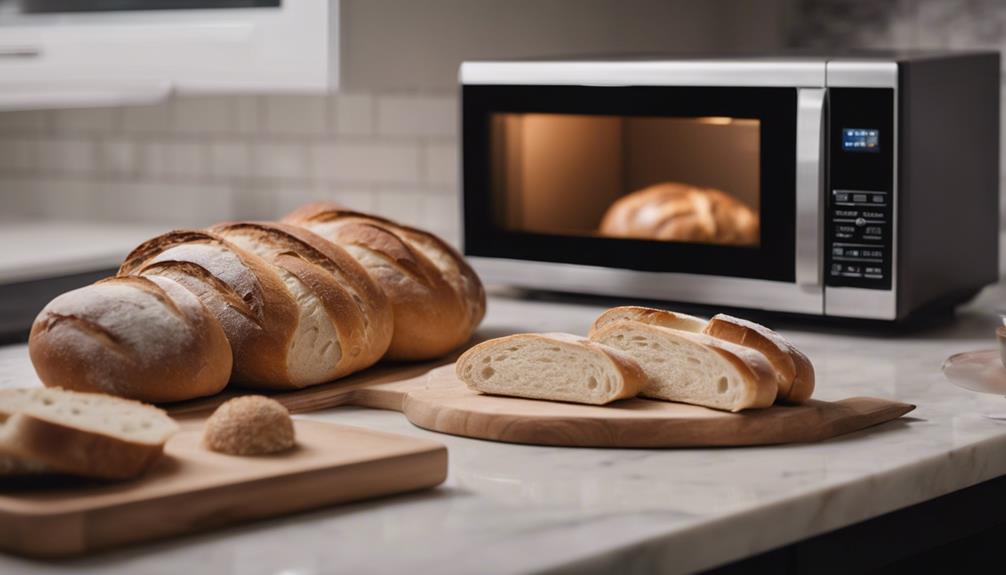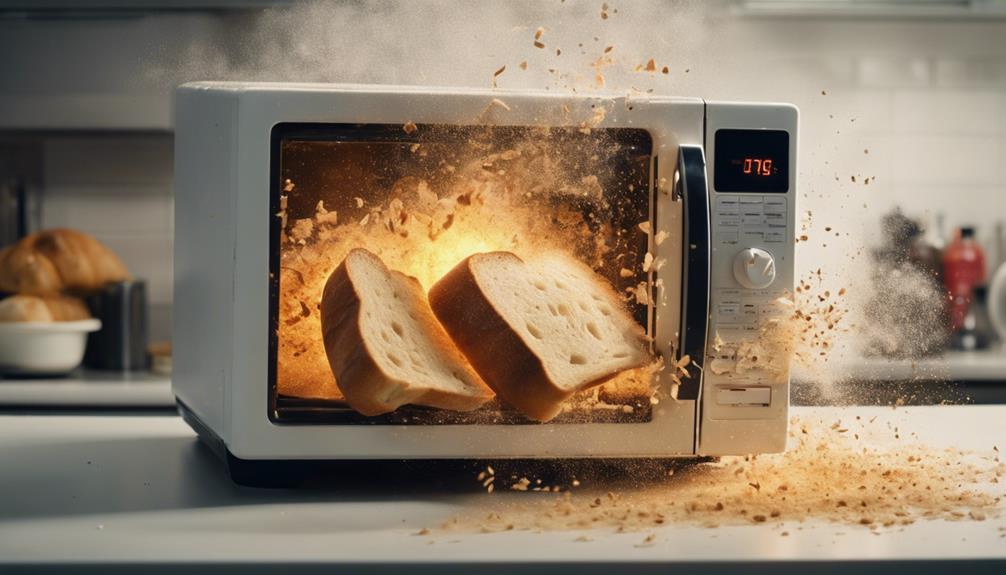Can You Microwave Bread
Yes, you can microwave bread to quickly warm it up, but it's important to note that microwaving bread can result in a soggy or rubbery texture. To avoid this, it's best to use the microwave on a low power setting or in short intervals, checking the bread frequently to prevent overcooking.
Additionally, placing a microwave-safe cover or a damp paper towel over the bread can help retain moisture and prevent it from drying out. Ultimately, while microwaving bread can be a convenient method for quickly warming it up, it may not result in the same texture and taste as traditional methods such as toasting or using an oven.
Key Takeaways
- Microwaving bread is feasible but requires caution for optimal results.
- Choose appropriate bread types and follow recommended heating tips.
- Avoid common mistakes like overheating or using high power settings.
- Proper technique, low power, and moisture retention are crucial for quality microwaved bread.
Pros and Cons of Microwaving Bread
Microwaving bread presents both advantages and drawbacks that impact the texture and overall quality of the final product. When you warm bread in the microwave, it can be a quick and convenient way to enjoy a warm snack or meal.
However, the downside is that microwaving bread can often lead to a dry or rubbery texture due to the lack of browning and moisture retention. This can result in a less appetizing bread-crumb texture, affecting the overall quality of the bread.
To avoid these issues, alternative options like using a toaster oven or a combination microwave with toasting functions are recommended for achieving efficient browning and a crispy texture, which microwaves may not provide.
Tips for Avoiding Rubber Texture
To achieve a more desirable texture when reheating bread in the microwave, it is essential to implement specific techniques that help prevent the development of a rubbery consistency. Avoid overcooking or overheating the bread, as this can lead to a rubbery texture.
Opt for a lower power setting and shorter cooking time to maintain the bread's texture. Covering the bread with a damp paper towel can add moisture and prevent it from becoming rubbery during reheating.
It is crucial to check the bread frequently while microwaving to ensure even heating and prevent rubberiness. After microwaving, allow the bread to sit for a minute to distribute the heat evenly and avoid a rubbery texture.
Best Bread Types for Microwaving

Soft and moist bread varieties such as white bread, whole wheat bread, and sandwich bread are recommended choices for optimal results when microwaving. These bread types heat evenly and retain their moisture, ensuring a pleasant texture when reheated.
When considering the best bread types for microwaving, it is essential to avoid dense varieties that may not warm up uniformly. Pre-sliced bread or bread rolls are convenient options as they warm up quickly and consistently in the microwave.
Additionally, bread with a higher moisture content like brioche or challah maintains its softness and freshness when microwaved. Gluten-free alternatives such as rice flour or potato bread can also be successfully reheated in the microwave, providing versatility for different dietary needs.
- White bread
- Whole wheat bread
- Sandwich bread
How to Properly Heat Bread
When aiming to properly heat bread in the microwave, it is essential to utilize a microwave-safe dish for optimal results.
To maintain the moisture of the bread while microwaving, wrap it in a damp paper towel. It is recommended to heat the bread on a low to medium power setting to prevent overheating and ensure even warming.
Check the bread after a short duration to gauge if it is warmed to your preference. Avoid using high power settings, as this can make the bread tough or rubbery.
Common Mistakes When Microwaving Bread

When microwaving bread, it is crucial to avoid uneven heating issues that can result in texture changes. Common mistakes include not covering the bread, using high power settings, and skipping the step of wrapping the bread in a damp paper towel.
These errors can lead to dry and rubbery textures, moisture loss, and overheating, affecting the overall quality of the bread.
Uneven Heating Issues
Inadequate rotation during the microwaving process can lead to uneven heating of bread due to its varying water content distribution. To minimize uneven heating issues when microwaving bread, consider the following:
- Use a kitchen towel to cover the bread loosely: Placing a damp kitchen towel over the bread can help retain moisture and prevent certain areas from drying out.
- Rotate the bread halfway through: By turning the bread around or flipping it over during the microwaving process, you can ensure more even heating throughout.
- Cut thicker slices into smaller pieces: Thicker slices of bread tend to heat less evenly, so cutting them into smaller pieces before microwaving can help promote uniform heating.
Texture Changes Observed
Numerous factors contribute to observed texture changes when microwaving bread, impacting its overall quality and taste.
When attempting to reheat dinner rolls in the microwave, one common mistake is failing to keep it moist. Microwaving bread can lead to a dry and rubbery texture due to the lack of browning and moisture retention.
The absence of browning in the microwave affects the appearance of the bread, making it less visually appealing. Moreover, water molecules do not escape easily in the microwave, impacting the texture and moisture content of the bread.
As a result, microwaving bread may sometimes result in a bread-crumb texture rather than the desired softness, affecting the overall eating experience.
Creative Microwave Bread Recipes
Let's explore the endless possibilities of microwave bread recipes in this discussion of Quick Microwave Bread Ideas, Easy Bread Recipes, and Microwave Bread Hacks.
These creative recipes offer a convenient way to whip up delicious bread in a matter of minutes, making them perfect for those hectic days.
With basic pantry staples and the freedom to experiment with various add-ins, you can easily customize your microwave bread to suit your taste preferences.
Quick Microwave Bread Ideas
For those seeking a convenient and swift baking solution, exploring quick microwave bread ideas offers a delightful array of creative recipes to try.
Here are some innovative ideas to whip up delicious microwave bread in no time:
- Make a quick microwave banana bread by mixing mashed bananas, flour, sugar, and baking powder in a microwave-safe dish.
- Try a savory microwave cornbread by combining cornmeal, flour, baking powder, milk, and egg in a microwave-safe container.
- Experiment with a microwave mug bread by mixing flour, baking powder, milk, and any desired mix-ins in a microwave-safe mug.
These quick microwave bread recipes provide a hassle-free way to enjoy freshly baked bread without the need for a traditional oven.
Easy Bread Recipes
What innovative twists can be added to traditional bread recipes when utilizing the microwave as a quick and convenient baking method? Microwave bread recipes offer a plethora of creative possibilities for experimenting in the kitchen. From savory herb loaves to sweet cinnamon rolls, the microwave can quickly bake a variety of bread types. By incorporating ingredients like cheese, olives, or nuts, you can elevate the flavors of your bread. Additionally, trying unique shaping techniques or using a towel to create patterns on the dough before microwaving can add visual appeal to your creations. Below is a table showcasing different creative microwave bread recipes that you can easily whip up in your kitchen.
| Recipe | Ingredients | Time | Tips |
|---|---|---|---|
| Cheesy Garlic Bread | Cheese, garlic, herbs | 5 minutes | Use a towel to shape the dough into twists for added flair. |
| Chocolate Chip Mug Bread | Flour, sugar, chocolate chips | 3 minutes | Mix in the chocolate chips just before microwaving for gooey goodness. |
| Herb Focaccia | Olive oil, rosemary, olives | 7 minutes | Press the olives into the dough before microwaving for a burst of flavor. |
Microwave Bread Hacks
When exploring innovative approaches to baking bread quickly and conveniently, the utilization of the microwave opens up a realm of creative possibilities with unique twists on traditional recipes. Microwave bread hacks offer a convenient way to enjoy hot bread without the need for a traditional oven. Here are some creative microwave bread recipes to try:
- Banana Bread: Whip up a moist and flavorful banana bread in just a few minutes using ripe bananas, flour, sugar, and a touch of cinnamon.
- Garlic Bread: Enjoy the aromatic flavors of garlic bread by toasting slices of bread with garlic butter in the microwave for a quick and tasty side dish.
- Mug Bread: Indulge in a single-serve bread experience by mixing flour, baking powder, milk, and any desired mix-ins in a microwave-safe mug for a personalized bread treat.
Frequently Asked Questions
Can Microwaving Bread Affect Its Nutritional Value?
Microwaving bread can impact its nutritional value through nutrient loss, particularly water-soluble vitamins. The process may alter taste slightly but can aid in moisture retention. Crust formation may vary, but microwaving remains a convenient option for quick warming or reheating.
Will Microwaving Bread Make It Stale Faster?
Microwaving bread can accelerate staleness by promoting rapid moisture loss during heating. To preserve freshness, consider bread storage in airtight containers. For optimal results, utilize microwave tips such as covering bread with a damp paper towel.
Is It Safe to Microwave Bread if It Contains Toppings or Fillings?
Microwaving bread with toppings requires caution for microwave safety. Uneven heating may occur due to fats, oils, or sugars in fillings like cheese or butter, leading to scorching. Opt for microwave-safe toppings such as deli meats for an evenly heated snack.
Can Microwaving Bread Cause It to Become Too Dry?
Microwaving bread can lead to moisture retention issues, potentially causing it to become too dry. While microwaving is a time-saving method for reheating, it may not maintain the bread's desired texture due to water molecules not escaping effectively.
How Does Microwaving Bread Compare to Toasting It in Terms of Taste and Texture?
When comparing microwaving bread to toasting it, the flavor profile differs significantly. Toasting enhances taste through browning reactions, providing a crunchier texture. Microwaving, however, preserves moisture, resulting in a softer texture but lacks the toasted flavor complexity.
Conclusion
In conclusion, microwaving bread can be a convenient option for quickly warming small portions or reheating slices.
By following proper techniques and choosing the right bread type, you can avoid the rubbery texture that often accompanies microwaved bread.
With a little care and attention, you can enjoy warm and moist bread in a matter of seconds, making it a practical and efficient method for enjoying a quick snack or meal.
